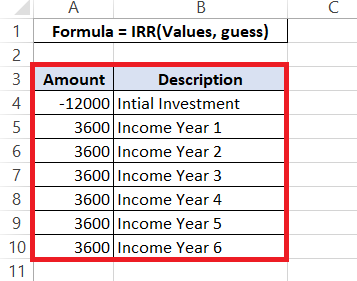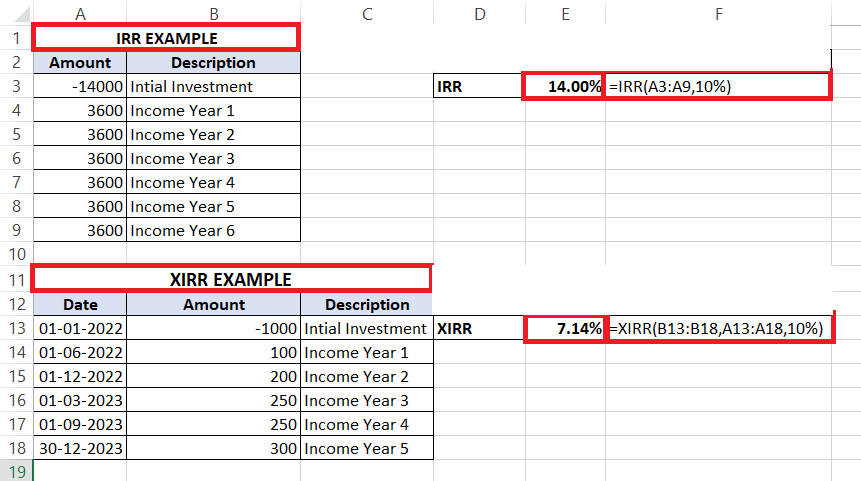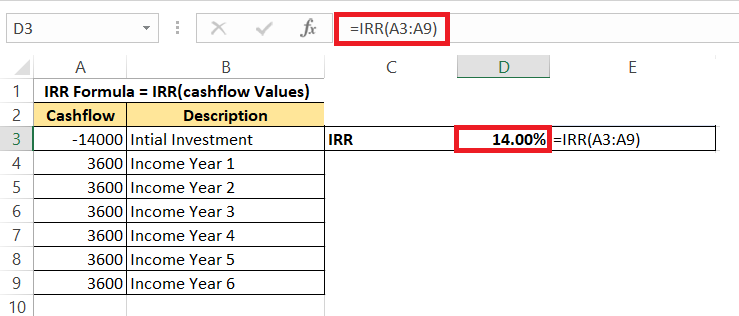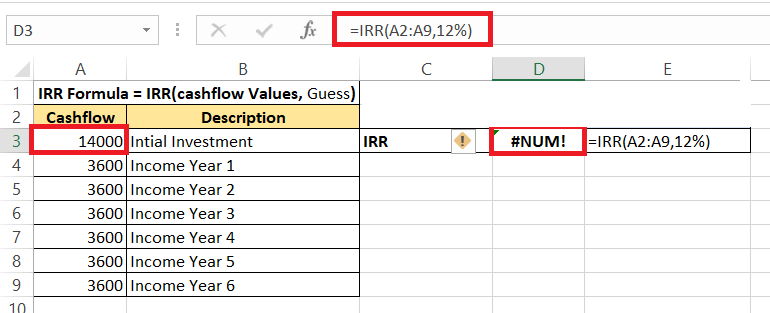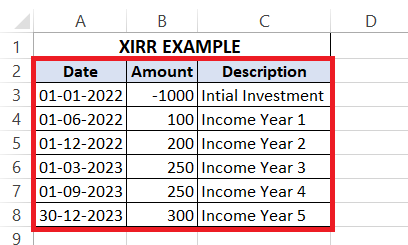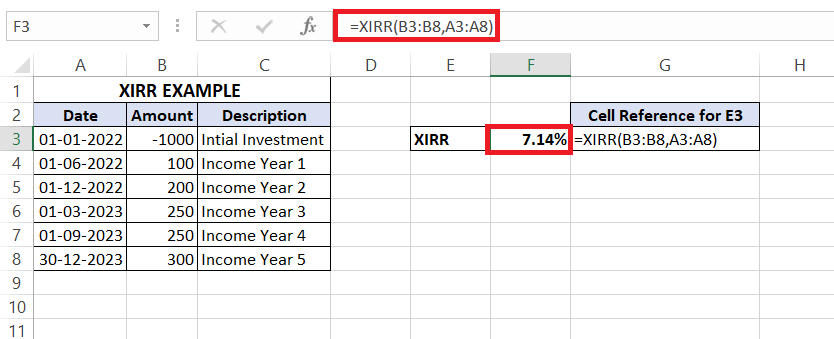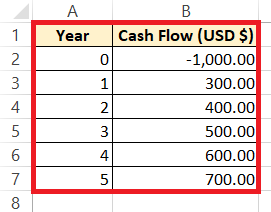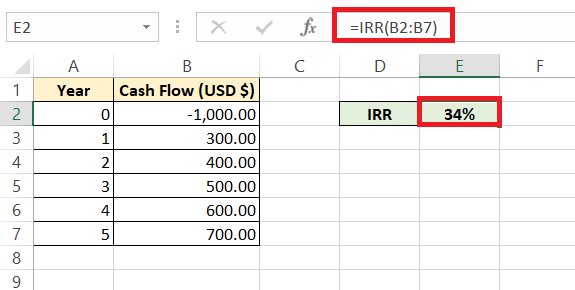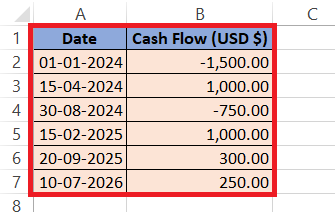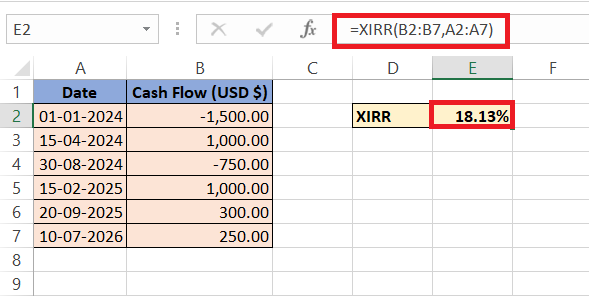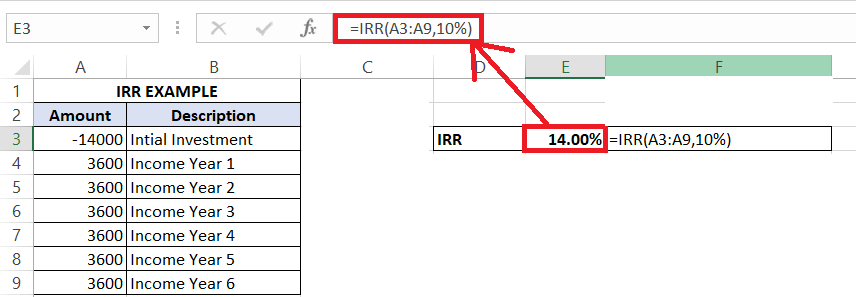The Internal Rate of Return (IRR) is a crucial metric for assessing the profitability of investments over time. It determines the interest rate at which the net present value of cash inflows and outflows equals zero, effectively measuring the expected annual rate of return on an investment. IRR calculator in Microsoft Excel is an invaluable tool for financial analysis that allows for efficient, data-driven investment decisions.
Key Takeaways:
- IRR measures the annualized rate of return for an investment, providing a percentage that represents its profitability. It helps determine whether an investment is likely to yield positive returns.
- Calculating IRR is vital for making informed investment decisions, as it highlights the potential profit and guides investors toward financially sound opportunities.
- Excel’s IRR and XIRR functions are essential for handling regular and irregular cash flows, respectively. IRR handles periodic cash flows, while XIRR is used for cash flows at irregular intervals.
- Common errors like #NUM! and #VALUE! can be addressed by ensuring at least one negative and one positive cash flow, and verifying that all input values are numeric and properly formatted.
- For investments with irregular cash flows, the XIRR function provides a more accurate rate of return by considering the specific timing of each cash flow, offering a comprehensive view of investment performance.
Table of Contents
Introduction to IRR in Excel
Defining the Internal Rate of Return (IRR)
The Internal Rate of Return, or IRR, is your go-to measure for the profitability of investments where you’re expecting a series of cash flows over time. It’s a bit like a financial detective that checks out the hidden return on your investment by saying, “This is the interest rate you’d need for your investment’s cash inflows and outflows to break even.
Importance of Calculating IRR for Investment Decisions
Calculating IRR is pivotal for savvy investment decisions because it shows you the potential profit an investment will generate in percentage terms. It’s like having a crystal ball that helps you foresee the financial effectiveness of your investments, guiding you to make well-informed, data-driven decisions that align with your financial goals.
Setting Up Your Excel Workspace for IRR Calculator
Organizing Cash Flow Data
To get started with IRR in Excel, it’s essential to have your ducks—or rather, your cash flows—in a row. Place your initial investment at the starting line, typically as a negative number because it’s cash going out. Then, list out the expected inflows in chronological order. Doing this sets you up for a smooth ride through the calculations, minimizing potential hiccups down the road.
The Necessary Excel Tools for IRR Computation
Your toolbox for cracking the IRR calculations in Excel includes a couple of handy functions: IRR and XIRR. While IRR deals with regular, periodic cash flows, XIRR is a whiz for when your cash flows are as unpredictable as a weather forecast—think different amounts at different times.
Step-by-Step Guide to Using the IRR Function
Inputting Cash Flows into the Function
When inputting cash flows into Excel’s IRR function, remember to embrace them all, positive and negative alike. Kickstart with your initial investment, then follow it up with the expected juicy returns.
It’s a simple selection game:
Click on the cell, type “=IRR(“, then drag over the cash flow cells, and hit enter. Voila, your IRR pops up, ready to be pondered.
INTERPRETATION: An Internal Rate of Return (IRR) of 14% indicates a projected annual return on investment. It suggests the investment exceeds its cost of capital, making it financially favorable. In decision-making, investments with IRRs surpassing 14% are typically preferred for their potential profitability.
Troubleshooting Common Errors
So, you’ve input your cash flows and hit enter, but Excel is throwing a tantrum with errors? Don’t fret—they’re usually fixable.
- With
#NUM!errors, it’s often a case of wild cash flows with no internal rate of return or multiple IRRs confusing Excel. Also, ensure that at least one value is negative (your investment) and one is positive (return). Here we see that the Initial Investment amount is not negative. Thus, IRR returns a #NUM! error.
For #VALUE! errors, check that you’re using numbers, not text or empty cells masquerading as data points. Here, the guess cell taken is a Text Cell. Thus, it returns a #VALUE! Error.
Advanced IRR Calculation Techniques
Working with Non-Periodic Cash Flows using XIRR
Got cash flows that waltz in whenever they please, with no respect for regular timing? Excel’s XIRR function has got your back. This advanced function is a cash-flow chameleon, seamlessly adapting to irregular intervals.
STEP 1: You just set the stage with two columns: one for the amounts and one for the dates.
STEP 2: Then weave your magic with the XIRR spell “=XIRR(values, dates)” and watch the true rate of return reveal itself.
Practical Examples of IRR Calculations in Excel
Simple Scenario: Calculating IRR for Annual Cash Flows
Imagine a simple case: you’ve got an investment with the same cash inflow every year, like clockwork. You’d jot down the yearly cash flow in Excel, with year zero marking the initial outlay. Then, call up the trusty =IRR() function, select your range of cash flows, and press enter. Excel will do the number-crunching and serve you the IRR on a silver platter, showing the annualized expected return.
STEP 1: Enter the cash flow data into columns A and B.
STEP 2: In cell E2, type “=IRR(B2:B7)” where column B represents the range of cash flows and press Enter. Excel will calculate the IRR, which in this case is approximately 10.87%.
INTERPRETATION: The calculated IRR of approximately 10.87% suggests that the investment’s internal rate of return is the annualized rate at which the net present value (NPV) of the cash flows equals zero. In simpler terms, it represents the expected annualized return of the investment over its lifespan.
Complex Scenario: IRR for Irregular Intervals
For the trickier times when cash flows play hard to get, popping up at random intervals, enter the scene: the XIRR function. Lay out your cash flows along with their respective dates in Excel, remembering they can be as sporadic as they come. Drop the XIRR formula into the mix, and like a financial Sherlock Holmes, it’ll deduce the more complex IRR, taking into account the actual timing of each cash flow.
STEP 1: Enter the cash flow data in columns A and B, with dates in column A and cash flows in column B.
STEP 2: In a cell, type “=XIRR(B2:B7, A2:A7)” where column B represents the range of cash flows and column A represents the range of dates & press Enter. Excel will calculate the XIRR, which in this case might be approximately 18.13%.
INTERPRETATION: The calculated XIRR of approximately 11.56% indicates the annualized rate of return considering the actual dates of each cash flow. It accounts for the irregular timing of cash flows, providing a more accurate measure of the investment’s performance compared to traditional IRR calculations.
Tips for Accurate and Efficient IRR Computations
Understanding and Using the ‘Guess’ Parameter
Sometimes, Excel’s IRR function needs a little nudge to start hunting for the answer. Enter the ‘Guess’ parameter. Think of it as a starting point for the calculation. If you’ve got no hint to offer, Excel will bravely start with 10%, a choice that’s often spot on. But when dealing with more intricate cash flow scenarios or when encountering multiple rates of return, tweaking the ‘Guess’ might just lead Excel to the correct IRR without a hiccup.
Even though in many cases, the guess does not affect the result, it’s an excellent tool to help Excel find the rate more efficiently, especially in complex scenarios that could have multiple IRR results. Remember, the closer your guess is to the actual IRR, the quicker Excel will arrive at the correct answer.
Interpreting the Results of Your IRR Calculation
What Does a Particular IRR Percentage Indicate?
Landing on a specific IRR percentage is like cracking a financial code; the number rings in the ears of investors as the melody of potential profit. An IRR that surpasses the hurdle rate signs of an investment likely to yield a return higher than the minimum you’d expect to earn. It’s the financial world’s nod of approval, encouraging you to go forth and invest. Conversely, an IRR that falls flat against the baseline suggests the investment might not be the money magnet you’re looking for.
- Positive IRR: It indicates that the investment generates returns exceeding the initial investment. It suggests profitability and serves as a measure of the investment’s attractiveness. Higher IRR values typically signify higher returns and lower investment risk.
- Negative IRR: It signifies that the investment yields returns lower than the initial outlay. It implies potential losses and often indicates an unprofitable venture. Negative IRR values suggest caution, as they may indicate that the investment fails to meet its cost of capital or faces significant financial hurdles.
- Zero IRR: It implies that the investment’s cash flows exactly offset the initial outlay. While rare, it suggests that the project neither generates profits nor incurs losses. This scenario may occur in break-even projects where the returns match the costs. Zero IRR values require careful assessment to determine the project’s viability and potential impacts on overall financial objectives.
Limitations of IRR and How to Address Them
While IRR shines in the spotlight as a go-to metric for gauging investment allure, it doesn’t quite bask in perfection. Its assumption that you can reinvest at the same rate as the IRR can be overly optimistic, not to mention it only flirts with percentages, leaving absolute dollar values waiting by the sidelines. To hedge against these quirks, pair IRR with its trusty companions like NPV or MIRR, which factor in actual dollar returns and more realistic reinvestment rates. It’s like getting a second opinion from a financial doctor—a wise move before you dock your money ship at the investment bay.
Additional Excel Functions to Supplement IRR Analysis
Leveraging NPV for a Holistic View
To truly get under the hood of an investment’s potential, leverage the Net Present Value (NPV). NPV steps in as a complementary companion to IRR, factoring in the magnitude and timing of each cash flow, not just the break-even rate. It’s like swapping out a telescope for a microscope; you’re now looking at the granular safeness of your investment, able to see the actual dollar benefit over time when considering your chosen discount rate.
INTERPRETATIONS:
- An IRR of 23.17% indicates the investment’s annualized rate of return, suggesting strong profitability and potential for high returns relative to the initial investment.
- The NPV of $3,582,131.80 reflects the present value of all cash flows discounted at a specified rate (usually the cost of capital). Positive NPV suggests the investment adds value, exceeding its cost. Together, they imply the investment is financially lucrative, with returns significantly outweighing costs, making it an attractive opportunity for investment.
Comparing IRR with Other Financial Metrics
While IRR gives you a glimpse at your investment’s efficiency, the financial landscape offers other vistas to explore. Balance the story by comparing IRR with metrics like NPV for net gains, Payback Period for break-even analysis, and Profitability Index to weigh the value created per dollar invested. This ensemble allows you to harvest a richer, more dimensional view of your investment’s performance, just as a well-rounded diet is healthier than feasting on one food group alone.
Cross-referencing IRR with other indicators ensures you’re not missing out on a crucial piece of the financial puzzle, giving you the confidence to make decisions with a 360-degree financial perspective.
FAQs
How to do IRR calculation in Excel?
To calculate IRR in Excel, arrange the relevant cash flow values in a single column. Then, simply use the IRR function by typing =IRR( and selecting your cash flow range. Excel will output the internal rate of return for that series of cash flows.
Can IRR Be Calculated Manually Without Excel?
Yes, IRR can be calculated manually, but brace yourself for quite the mathematical journey. It involves solving a complex polynomial equation where the net present value equals zero. Frequently, trial-and-error is used to approximate the rate, making Excel a much-preferred shortcut for most.
How Do I Handle #NUM! Errors When Computing IRR?
When facing #NUM! errors while computing IRR in Excel, confirm there’s at least one positive and one negative cash flow. If still unresolved, try setting an initial ‘Guess’ value in the IRR formula, or review the cash flows for payment timing accuracy.
What Is the Difference Between IRR and XIRR Functions?
The difference lies in timing: IRR assumes equal interval cash flows, while XIRR is for when cash flows are as irregular as leap years. XIRR needs specific dates for each cash flow, giving a more precise rate of return for uneven investment schedules.
How Can I Calculate Monthly IRR in Excel?
To calculate monthly IRR in Excel, gather your monthly cash flows. Use the XIRR function, =XIRR(values, dates), inputting your cash flows and corresponding dates. Excel will deliver the monthly internal rate of return adjusted for the timing of each cash flow.
John Michaloudis is a former accountant and finance analyst at General Electric, a Microsoft MVP since 2020, an Amazon #1 bestselling author of 4 Microsoft Excel books and teacher of Microsoft Excel & Office over at his flagship MyExcelOnline Academy Online Course.

